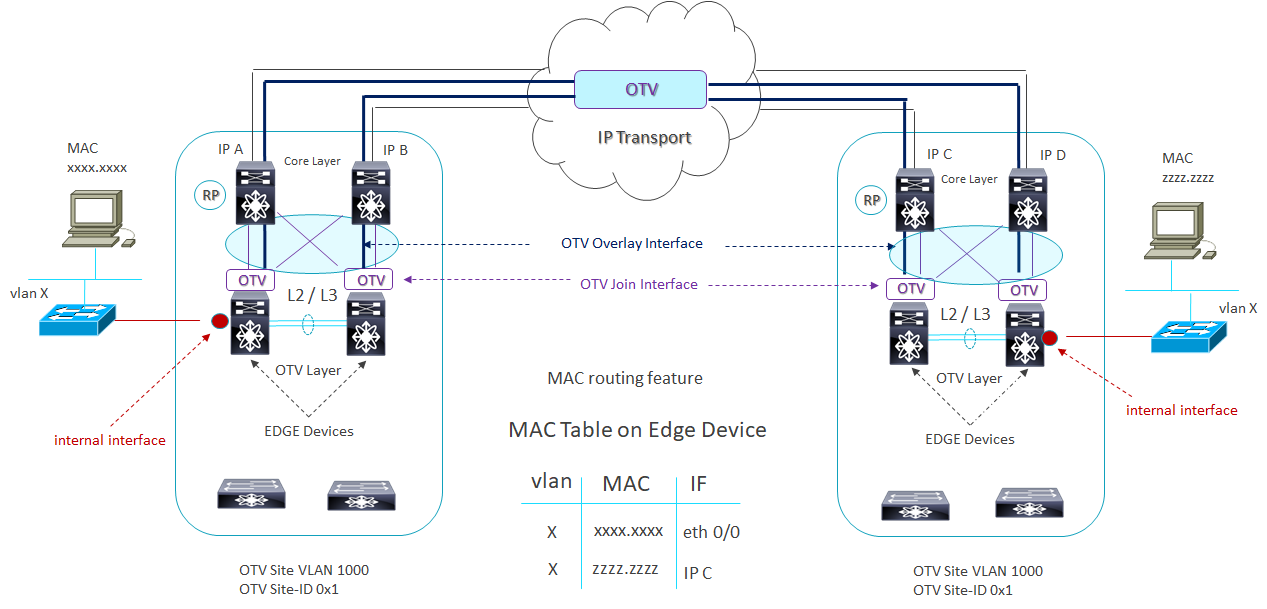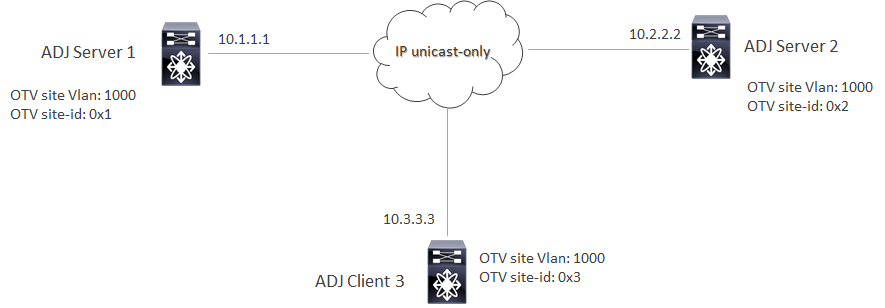OTV example-configuration per interface type
13.12 2019 | by massimilianoIn questo documento metteremo in evidenza una procedura di configurazione OTV per Architettura di Riferimento: OTV […]
https://www.ingegnerianetworking.com/wp-content/uploads/2019/12/otv-design-37a.png
In questo documento metteremo in evidenza una procedura di configurazione OTV per
Architettura di Riferimento:

OTV internal interface:
interface port-channel 200
switchport
switchport mode trunk
switchport trunk native vlan 100
switchport trunk allowed vlan 10,12,14,20-30,40-50,70-99,1000
spanning-tree port type normal
mac packet-classify
!
interface ethernet 3/23
switchport
switchport mode trunk
switchport trunk native vlan 100
switchport trunk allowed vlan 10,12,14,20-30,40-50,70-99,1000
spanning-tree port type normal
channel-group 200 mode active
no shut
!
interface ethernet 7/23
switchport
switchport mode trunk
switchport trunk native vlan 100
switchport trunk allowed vlan 10,12,14,20-30,40-50,70-99,1000
spanning-tree port type normal
channel-group 200 mode active
no shut
!
OTV join interface:
interface port-channel 300
mtu 1600
ip address 172.16.1.1/30
ip ospf network point-to-point
ip router ospf 10 area 0.0.0.0
ip igmp version 3
no shut
!
interface ethernet 4/16
mtu 1600
channel-group 300 mode active
no shut
!
interface ethernet 5/18
mtu 1600
channel-group 300 mode active
no shut
!
OTV overlay interface:
interface overlay 1
otv join-interface port-channel 300
otv control-group 239.1.1.1
otv data-group 232.0.0.0/24
otv extend-vlan 10,12,14,20-30,40-50,70-99
no shut
!
OTV site vlan:
vlan 1000
name otv-site-vlan
otv site-vlan 1000
!
otv site-identifier 0x1
OTV MULTICAST Enabled transport overlay
OTV Edge Devices sono configurati per unirsi ad uno specifico ASM (Any Source Multicast) group; in questo modo ogni OTV edge devices diventa receiver e source multicast traffic;
Le interfacce in upstream layer 3 debbono essere configurate in PIM sparse-mode ed ogni device deve specificare il SSM group da usare;
Un RP (Rendezvou Point) router deve essere definito (due RP per ridondanza, dove quest’ultima può essere ottenuta usando Anycast RP);
OTV unicast Enabled transport overlay
Nella situazione dove non è possibile avere un Multicast Overlay Transport, è possibile utilizzare un trasporto di tipo unicast-only; la differenza sta che ogni Edge Device deve creare multiple copie di ogni control-plane packet relativo ad ogni edge devices remoto facente parte dello stesso logical overlay interface.
Un nuovo concetto di adiancenza è introdotto: OTV adjacency server; ogni OTV device cerca di unirsi ad una specifica logical overlay interface avendo il bisogno di registro verso il server inviando hello message; questi messaggi servono al server per costruire una lista di tutti gli OTV devices che dovranno far parte dello stesso dominio overlay (unicast-replication-list).

ADJ Server 1
otv side-identifier 0x1
otv site-vlan 1000
interface overlay 1
otv join-interface port-channel 300
otv adjacency-server unicast-only
otv extend-vlan 10,12,14,20-30,40-50,70-99
ADJ Server 2
otv side-identifier 0x2
otv site-vlan 1000
interface overlay 1
otv join-interface port-channel 300
otv adjacency-server unicast-only
otv use-adjacency-server 10.1.1.1 unicast-only
otv extend-vlan 10,12,14,20-30,40-50,70-99
ADJ Client 1
otv side-identifier 0x3
otv site-vlan 1000
interface overlay 1
otv join-interface port-channel 300
otv use-adjacency-server 10.1.1.1 10.2.2.2 unicast-only
otv extend-vlan 10,12,14,20-30,40-50,70-99
!
!
show otv overlay 1